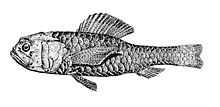Large scale fish
| Large scale fish | ||||||||||||
|---|---|---|---|---|---|---|---|---|---|---|---|---|

1. Scopelogadus mizolepis , 2. Poromitra megalops , 3. Poromitra nigrofulva , 4. Scopeloberyx robustus , 5. Melamphaes suborbitalis , 6 + 7. Poromitra frontosa |
||||||||||||
| Systematics | ||||||||||||
|
||||||||||||
| Scientific name | ||||||||||||
| Melamphaidae | ||||||||||||
| Gill , 1893 |
The large scale fish (Melamphaidae) live with over 65 species in five genera in all oceans , with the exception of the northern polar sea and the Mediterranean . They are the most species-rich family of the mucous heads (Beryciformes).
Appearance
Large scale fish have an elongated body that is slightly compressed at the sides. Her scaleless head is provided with sharp, skin-covered thorns and prongs. The bones of the head are paper thin and keeled. Like other mucous head-like (Beryciformes) the large scale fish have mucus-filled grooves on the skull, which probably improve the sensory abilities of the animals. In contrast, the lateral line is no longer present or has receded to one or two pore-bearing scales. The eponymous large cycloid scales are usually dark brown or black in color. They fall off easily. With the exception of Poromitra megalops , the eyes are very small. The gap in the mouth protrudes behind the eye. Large scale fish have a single dorsal fin and a forked caudal fin. In front of the caudal fin, there are three to four spines above and below on the caudal fin stalk. The dorsal fin is supported by three weak spines and subsequent soft rays, the ventral fins have a sting ray and six to eight soft rays. Large scale fish are between 2 and 18 centimeters long. The spine consists of 24 to 31 vertebrae.
habitat
Large scale fish live at depths of 0 to 4000 meters. Many migrate during the day, during the day they stay at depths of less than 400 meters and at night they rise to the surface (10–100 meters). Since they find more prey here, large scale fish prefer to stay on the continental slopes and on submarine mountains.
Reproduction
Large scale fish spawn pelagically in open water. Eggs and larvae belong to the zooplankton and float in layers of water above 200 meters. After the metamorphosis into the adult fish, the animals move to deeper layers, into the habitat of the parent animals.
Others
Large scale fish are eaten by dolphins , albatrosses , tuna and squids . They eat zooplankton themselves, like copepods and other small pelagic crustaceans.
Systematics
There are over 65 species in five genera:
- Genus Melamphaes
- Melamphaes acanthomus Ebeling, 1962 .
- Melamphaes contradictorius Kotlyar, 2015 .
- Melamphaes danae Ebeling, 1962 .
- Melamphaes ebelingi Keene, 1973 .
- Melamphaes eulepis Ebeling, 1962 .
- Melamphaes eurous Kotlyar, 2016 .
- Melamphaes falsidicus Kotlyar, 2011 .
- Melamphaes hubbsi Ebeling, 1962 .
- Melamphaes inconspicuus Kotlyar, 2015 .
- Melamphaes indicus Ebeling, 1962 .
- Melamphaes janae Ebeling, 1962 .
- Melamphaes kobylyanskyi Kotlyar, 2015 .
- Melamphaes laeviceps Ebeling, 1962 .
- Melamphaes lentiginosus Kotlyar, 2015 .
- Melamphaes leprus Ebeling, 1962 .
- Melamphaes longivelis Parr, 1933 .
- Melamphaes lugubris Gilbert, 1891 .
- Melamphaes macrocephalus Parr, 1931 .
- Melamphaes manifestus Kotlyar, 2011 .
- Melamphaes microps ( Günther , 1878) .
- Melamphaes nikolayi Kotlyar, 2012 .
- Melamphaes occlusus Kotlyar, 2012 .
- Melamphaes pachystomus Kotlyar, 2011 .
- Melamphaes parini Kotlyar, 1999 .
- Melamphaes parvus Ebeling, 1962 .
- Melamphaes polylepis Ebeling, 1962 .
- Melamphaes proximus Kotlyar, 2015 .
- Melamphaes pumilus Ebeling, 1962 .
- Melamphaes shcherbachevi Kotlyar, 2015 .
- Melamphaes simus Ebeling, 1962 .
- Melamphaes spinifer Ebeling, 1962 .
- Melamphaes suborbitalis ( Gill , 1883) .
- Melamphaes succedan from Kotlyar, 2015 .
- Melamphaes typhlops (Lowe, 1843) .
- Melamphaes xestoachidus Kotlyar, 2011 .
- Genus Poromitra
- Poromitra capito Goode & Bean, 1883 .
- Poromitra crassa Parin & Ebeling, 1980 .
- Poromitra crassiceps (Günther, 1878) .
- Poromitra gibbsi Parin & Borodulina, 1989 .
- Poromitra megalops (Lütken, 1877) .
- Poromitra oscitans Ebeling, 1975 .
- Poromitra unicornis (Gilbert, 1905) .
- Genus Scopeloberyx
- Scopeloberyx microlepis (Norman, 1937) .
- Scopeloberyx opisthopterus (Parr, 1933) .
- Scopeloberyx robustus (Günther, 1887) .
- Scopeloberyx rubriventer (Koefoed, 1953) .
- Genus Scopelogadus
- Scopelogadus beanii (Günther, 1887) .
- Scopelogadus mizolepis Günther, 1878 .
- Scopelogadus unispinis Ebeling & Weed, 1963 .
- Genus Sio
- Sio nordenskjoldii (Lönnberg, 1905) .
literature
- Kurt Fiedler: Textbook of Special Zoology, Volume II, Part 2: Fish . Gustav Fischer Verlag Jena, 1991, ISBN 3-334-00339-6
- Joseph S. Nelson : Fishes of the World . John Wiley & Sons, 2006, ISBN 0-471-25031-7
Individual evidence
- ↑ Kotlyar, AN (2011): Revision of Genus Melamphaes (Melamphaidae). Multi-raker species. : Journal of Ichthyology, 51 (8): 557-580.
- ↑ Kotlyar, AN (2015): Revision of the Genus Melamphaes (Melamphaidae): 2. Oligo-Raker Species: M. longivelis Parr, M. inconspicuus sp. n., M. kobylyanskyi sp. n. Journal of Ichthyology, 55 (3): 311-318.
- ↑ Kotlyar, AN (2015): Revision of the genus Melamphaes (Melamphaidae): 4. oligo-raker species: M. parvus Ebeling, M. janae Ebeling, M. lentiginosus sp. n., M. shcherbachevi sp. n. Journal of Ichthyology, 55 (6): 765-777.
- ↑ Kotlyar, AN (2016): Revision of the Genus Melamphaes (Melamphaidae). 5. Oligo-Raker Species: M. indicus, M. eurous, and M. typhlops. Journal of Ichthyology, 56 (1): 19-30.
Web links
- Large scale fish on Fishbase.org (English)







